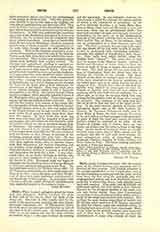

Choir. — There is much ambiguity about the terms choir and presbytery. Strictly speaking, the choir is that part of the church where the stalls of the clergy are. The term is often loosely used for the whole of the eastern arm, including the choir proper, sanctuary, retro-choir, etc. At Westminster Abbey the stalls are in the east nave and therefore no part of the choir is in the eastern arm. At Canterbury the stalls are in the eastern arm and the choir occupies its western bays, i.e. the space between the crossing and the sanctuary. In non-collegiate churches the eastern arm is called the chancel, the eastern portion of which is the presbytery or sanctuary. In the earliest Christian churches, e.g. Santa Maria Maggiore at Rome, there were but two parts, a nave and sanctuary; there was no architectural choir. The sanctuary occupied the apse, and the apse was joined immediately to the nave, or, in the double-aisled basilicas of the fourth century, such as those of St. Peter and St. Paul at Rome, to the transept; there was no interposition of a choir between nave and apse. The choir was simply the east part of the nave, and was fenced off by low walls, usually of marble, carved or perforated with interlacing patterns—peacocks (the symbol of immortality), lions, doves, etc. These walls were called cancelli, hence the English word “chancel”. The word choir is first used by writers of the Western Church. Isidore of Seville and Honorius of Autun derive it from the corona or circle of clergy or singers who surrounded the altar. The choir proper did not exist until the time of Constantine, when the clergy were able to develop the services of the Church. The introduction of the choir, or enclosed space in the center of the nave, attached to the bema or presbytery, as the raised space came to be called, was the last great change of plan. Round three sides of this choir the faithful were allowed to congregate to hear the Gospels or Epistles read from the two pulpits or ambones, which were built into its enclosure, one on either side; or to hear the services which were read or sung by the inferior order of clergy who occupied its precincts. The enclosure of the choir was kept low, so as not to hide the view of the raised presbytery. In the southwestern districts of France and throughout Spain, also in St. John Lateran, St. Clement, St. Laurence Without-the-walls, and St. Mary Major at Rome, the choir occupies the center of the nave with an enclosed passage to the sanctuary. In parts of Italy the choir still retains its ancient position behind or eastward of the altar. In the Duomo of Fiesole, and at Lucca, there are two choirs, one behind and the other in front of the high altar. In the north of Germany choirs are usually elevated upon crypts (that of Milan stands over the confessio) and shut in with solid stone screens; the same arrangement exists at Canterbury, Auch, Augsburg, Chartres, Bourges, St-Denis, Amiens, and Notre-Dame in Paris. The finest existing enclosures are those of Paris and Amiens.
THOMAS H. POOLE

